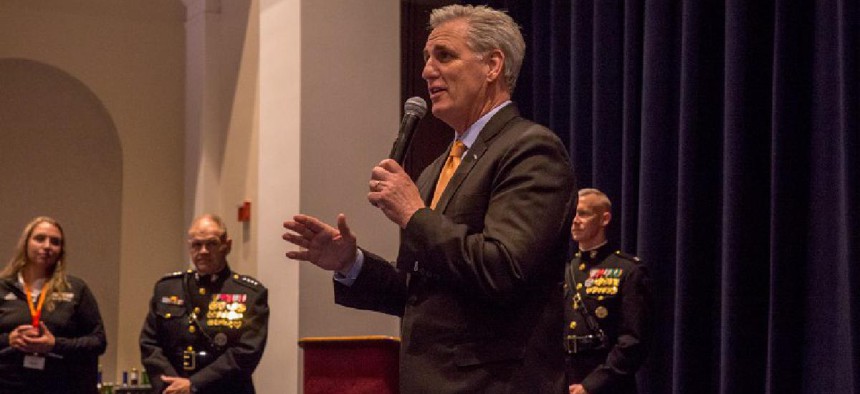Top House Republican pushes back on government telework

House Minority Leader Kevin McCarthy (R-Calif.) isn’t the only Republican lawmaker asking questions about the productivity of teleworking federal employees.

House Majority Leader Kevin McCarthy, shown here at a May 2018 ceremony at Marine Barracks in Washington, D.C., wants answers on the federal government's telework posture. (Photo credit: U.S. Marine Corps photo by Sgt. Robert Knapp)
Rep. Kevin McCarthy (R-Calif.), top House Republican, has “serious questions” about wide-scale government telework, one of the workplace flexibilities the Biden-Harris administration has explicitly established as a tool to be leveraged into the future, even after the pandemic subsides.
McCarthy says that he has doubts, particularly about the effects of telework on service levels for Americans seeking government benefits.
“The Biden Administration's ‘maximum telework’ edict is not working for the American people, many of whom are struggling to secure in-person services from their federal government,” McCarthy wrote in a Dec. 8 letter to leadership at the Office of Management and Budget, the Office of Personnel Management and the General Services Administration.
“Instead of focusing on how the federal workforce can better function in the future, it is critical that your agencies focus on the issues at hand now,” he continued.
McCarthy wants answers about why the government remains on a “maximum telework” status; the number of feds currently teleworking; and the re-entry plans submitted by agencies to the White House-led Safer Federal Workforce Taskforce.
Another question is how agencies have been monitoring “the efficacy and productivity” of teleworking employees.
McCarthy pointed to backlog of claims for veteran benefits at the Veterans Administration, which has 256,369 disability compensation and pension claims that’ve been pending for over 125 days, as of Dec. 4.
That backlog has long been an issue for the agency, although it did shoot up during the pandemic, at least in part because of a temporary pause of the in-person exams needed to determine eligibility for the benefits. Other backlogs at the National Archives and Records Administration, which houses records needed for the claims process, have also contributed to the VA backlog.
McCarthy also pointed to service levels at the Social Security Administration. That agency is beginning a re-entry process for field office and teleservice feds on Jan. 3, 2022.
The House Minority Leader isn’t the only Republican lawmaker voicing concerns.
This week, Senator Ron Johnson (R-Wis.) also sent letters looking for information on telework levels and how agencies are “tracking employee productivity” from seventeen agencies.
In a recent subcommittee hearing on the House Oversight and Reform Committee, top subcommittee Republican Rep. Jody Hice (R-Ga.) also stressed the need for metrics to measure productivity from feds, saying that telework posed a risk of “fraud.”
In that hearing, Michelle Amante, vice president for federal workforce programs at the nonpartisan Partnership for Public Service, said “I don’t think we should start with the premise that there will absolutely be fraud,” continuing on to agree that “establishing performance metrics is the key.”
How productivity measurement might change in a remote setting was also a topic of discussion this week at the Senior Executives Association’s Federal Executive Virtual Leadership Summit.
The U.S. Patent and Trademark Office started its telework program in 1997. Fred Steckler, the agency’s chief administrative officer, said that setting clear expectations and measurable performance plans is key to success.
It also takes buy-in, he said during a Dec. 9 session.
“It really gets down to a change of mindset that needs to happen if you weren’t already operating in a remote or hybrid environment, and it’s a change in mindset from both the managers perspective and the employees perspective,” he said.
Federal employees themselves reported in the 2021 Federal Employee Viewpoint Survey a significant drop in being able to “always” or “most of the time” meet the needs of customers during the pandemic - 86% - as opposed to before the pandemic - 94%.
A survey by the National Treasury Employees Union, which has said it will continue to advocate for increased telework post-pandemic, found that 50% of the 13,800 respondents reported that their productivity "increased a lot” while teleworking. Twenty-four point one percent reported no change in productivity and almost 5% said that their productivity "decreased a little."
The American Federation of Government Employees has also released survey results of its own members finding that 62% of respondents said that their productivity increased “a lot” while teleworking during the pandemic.






